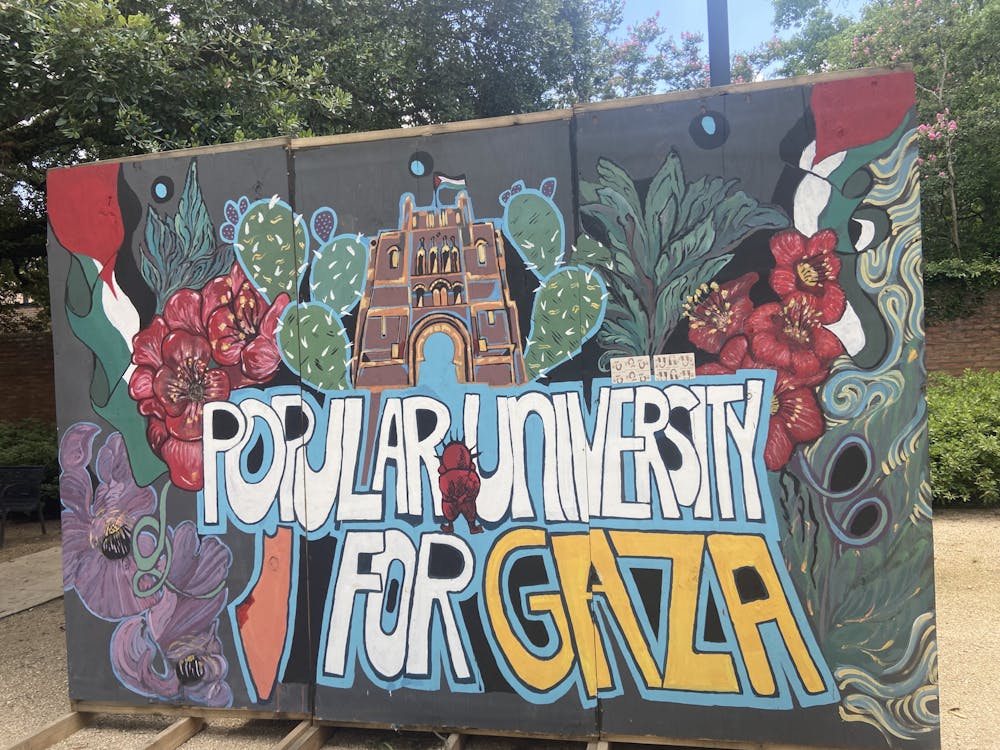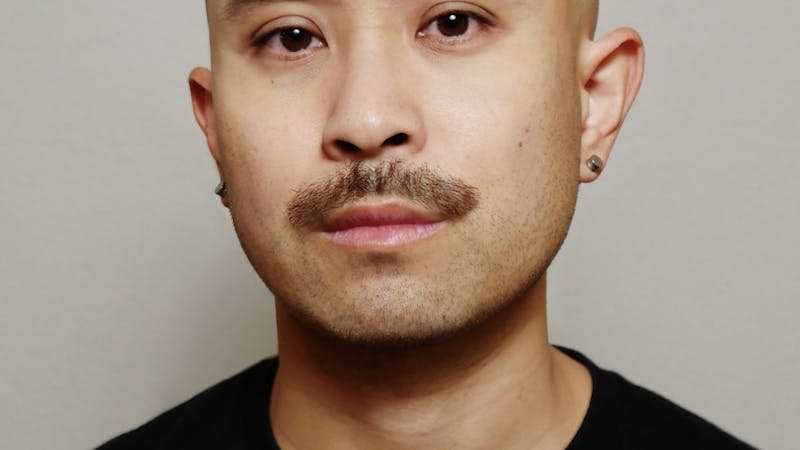Students explore activism and solidarity through art

An anonymous student, Jack*, said he spearheaded the design for a mural that stood outside Rice SJP’s “liberated zone” last spring. Photo courtesy of Jack.
[03/18/2025 2:52 p.m.] Editor’s Note: In the months since this story first ran, the Trump administration has arrested and attempted to deport two visa-holding college students for their involvement in campus protests about the Israel-Hamas war. Understanding this new danger to students nationwide and at Rice University, the Thresher has decided to grant retroactive anonymity to one student, who we originally identified in this story by his full name. The anonymous student was given a pseudonym, which has been marked with an asterisk on the first mention.
The Thresher takes seriously concerns about the safety and security of our international students. Moving forward, we will continue to evaluate our reporting and ethical standards with these concerns in mind.
While some college students use their voices to protest and call for social change, others opt for a different medium of expression, through painting, sculpture or photography. Some Rice students say activism through art has proven to be a fulfilling avenue of expressing dissent that resounds just as loudly as their voices.
Some artists advocate for topics relating to their identity. In this case, activism may be integral to their art due to the role of their identity in their lives. Camille Neal-Harris is one such artist, whose wood, plaster and metal sculptures express her beliefs on race and equality.
“A lot of my pieces have to do with the sky and sun, culture and emotional development,” Neal-Harris, a Will Rice College senior, said. “I think because I am a Black woman, concepts of race, culture and advocating against the systems that cause discrimination are embedded in every piece I make, whether I say it explicitly or not.”
Others find themselves using art to understand and represent the world. Jack* said his multi-media art reflects Palestinian resistance and solidarity across movements.
“I think in absurd terms because the world today — particularly in its political dimensions — often feels absurd,” Jack said. “I believe young people are increasingly aware of and frustrated by these conditions, and my work aims to create spaces for collective exchange, reflection and expression.”
Many artists find that their artwork becomes informed by politics and activism. Sophia Rohlfsen ’24 said she finds that her photography work indirectly expresses her views and thoughts about needed change.
“My work is not overtly political, but politics will always inform my artwork,” Rohlfsen said. “I don’t know if my work is ever trying to prove a point. I think I just try to show what I find interesting about a subject.”
The intersection of activism and art also allows students to get involved in the greater student community. Jack had one such experience through an installation at Rice Students for Justice in Palestine’s “liberated zone,” set up last spring.
“Last semester, some of my peers and I conceptualized this installation as a collective project,” Jack said. “We constructed a mural framework that allowed community members to paint freely within the designated space on large wooden panels. This piece took on additional significance in response to administrative pushback against student protests — organizing a protest was restricted due to censorship, and students were closely monitored.”
According to Jack, artistic spaces also foster an environment that allows for creativity and activism to collide.
“I regularly seek input from my friends and classmates on the visuals I produce,” Jack said. “Through this collaborative process, art becomes a medium of engagement, encouraging others to reflect on their roles in broader social issues.”
According to Jack, the diverse environment at Rice allows him to challenge conventional expression through a variety of mediums.
“On a campus as multifaceted as ours, art has the power to reshape how we exchange ideas and create new forms of cultural expression,” Jack said. “While words are important, visual forms — whether posters, murals or installations — offer a tactile, immediate way to engage with the world.”
More from The Rice Thresher

Andrew Thomas Huang puts visuals and identity to song
Houston is welcoming the Grammy-nominated figure behind the music videos of Björk and FKA twigs on June 27.

Live it up this summer with these Houston shows
Staying in Houston this summer and wondering how to make the most of your time? Fortunately, you're in luck, there's no shortage of amazing shows and performances happening around the city. From live music to ballet and everything in between, here are some events coming up this month and next!

Review: 'Adults' couldn’t have matured better
Sitcoms are back, and they’re actually funny. FX’s “Adults” is an original comedy following a friend group navigating New York and what it means to be an “actual adult.” From ever-mounting medical bills to chaotic dinner parties, the group attempts to tackle this new stage of life together, only to be met with varying levels of success.

Please note All comments are eligible for publication by The Rice Thresher.